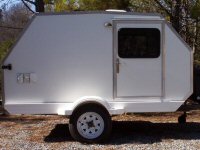Uber Ultra-light tear
Uber Ultra-light tear
OK, so I moved the Uber Ultra thread to the build area now that the general layout has been presented. I'm so far thinking of fiberglass facesheets with a foam core, reinforced locally as required. I liked the A-Frame concept that Andrew laid out because I got a couple of special ideas for that. I'd like to work on a list of weight-saving ideas so if some of you have been thinking light-weight, or have a weight-saving idea, I'd love to hear about it.
So far:
composite sandwich construction
A-frame only -- no other sub frame
torsion axle
cargo netting - no cabinet doors (compare against 1/8 in aircraft-grade door with trim)
1 3/4 ball
10" tires (how much heavier than 8" tires?)
Alloy wheels?
composite shelves and galley divider
camp stove, small propane
If AC, which is lighter 5000 BTU Home Depot AC or Pet Cool
Which heater lighter
Weight costs, so I'm looking for light-weight solutions, even if they are marginally, and maybe significantly more expensive (if cool factor is higher the price can be justified!)
Thanks for the help. I'll post some profiles with a layout soon.
So far:
composite sandwich construction
A-frame only -- no other sub frame
torsion axle
cargo netting - no cabinet doors (compare against 1/8 in aircraft-grade door with trim)
1 3/4 ball
10" tires (how much heavier than 8" tires?)
Alloy wheels?
composite shelves and galley divider
camp stove, small propane
If AC, which is lighter 5000 BTU Home Depot AC or Pet Cool
Which heater lighter
Weight costs, so I'm looking for light-weight solutions, even if they are marginally, and maybe significantly more expensive (if cool factor is higher the price can be justified!)
Thanks for the help. I'll post some profiles with a layout soon.
-

kennyrayandersen - 1000 Club

- Posts: 1750
- Images: 38
- Joined: Sun Apr 29, 2007 10:27 pm
- Location: TX
Re: Uber Ultra-light tear
kennyrayandersen wrote:...
10" tires (how much heavier than 8" tires?)...
The Carlisle web site allows you to download a copy of their catalog, which has weights for both tires and wheels. They don't have every possible size, but they have a good selection so representative components are likely shown... and it is likely easier to open up the copy which has been downloaded than to hit a web site every time you're curious about a number.
At a glance, it looks like going from 4.80-8 to any 10" tire would greatly increase the weight, because all of the Carlisle 10" tires are very wide... a 12" setup would be lighter! Maybe other brands have narrow 10" tires.
- 8" - 4.80x8 tire at 5.8 lb, on 8x3.75 steel wheel at 4.7 lb; 21.0 lb total
10" - 20.5x8.0-10 tire at 14.35 lb, on 10x6 steel wheel at 10.6 lb; 49.9 lb total
12" - 4.80-12 tire at 9.7 lb, on 12x4 steel wheel at 10.0 lb total; 39.4 lb total
The extra diameter doesn't necessarily cost too much in weight... a taller and skinny tire of the same capacity might not be much heavier than a shorter and wider one. In this case, there are no skinner 10" or 12" tires to match the very low load capacity requirement.
kennyrayandersen wrote:...
Alloy wheels?...
In the Carlisle selection, there are no 8" or 10" alloys, and in the 12x4 size the alloy is heavier than the steel (11 lb versus 10 lb). Although an aluminum alloy wheel can be lighter, often they are not... the same thing occurs in wheels for cars.
- brian_bp
- 1000 Club

- Posts: 1355
- Images: 9
- Joined: Sun Nov 19, 2006 1:25 pm
- Location: Alberta

